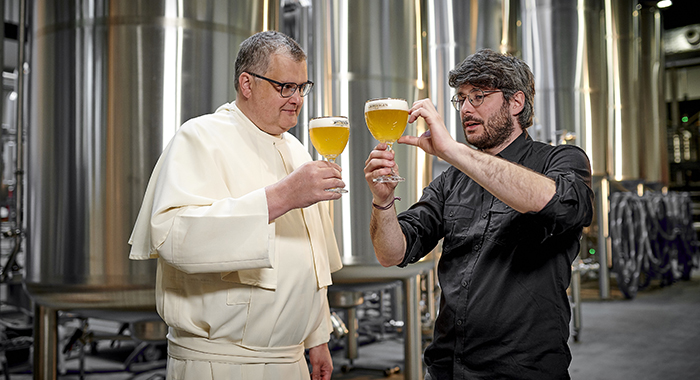From Brewing Beer to Breeding Black Labs
Father Andrew Ciferni of Daylesford Abbey, in Paoli, Pennsylvania, is a fan of Norbertine-brewed beers. “They are richer and have a more distinctive taste,” he says. They also have a higher alcohol content than mass-produced beers. “They are not,” says the former director of the Center for Norbertine Studies, “for drinking with pizza.”
Brewing is one of the ways in which Norbertine abbeys support themselves financially. This year the Norbertine order’s capacity for sustaining itself is on full display as the Center for Norbertine Studies, in collaboration with Norbertines around the world, celebrates 900 years of the order with a series of events in various corners of the world.
Historically, Norbertine business enterprises have ranged from St. Norbert Abbey’s forays into broadcasting to the wine-making of the sisters of Sint-Catharinadal, in the Netherlands. In other corners of the Norbertine world, cheese-making and manuscript restoration continue. “A lot of our entrepreneurial spirit is about abbey survival and ministry to the region: spiritual and material—beer, bread, pharmacy, education, agronomy—because we commit to one place for life we need to be concerned about,” Ciferni says.
That broadcasting connection to the De Pere abbey? Before the age of television, the first commercial radio station in northern Wisconsin, WHBY, was built on the St. Norbert College campus by student engineer and inventor Cletus Collom, a student at the college during the mid-1920s. He was supported by Father Ignatius Van Dyke, Coach George Carey and a Norbertine seminarian, James Wagner. Young James, who had always enjoyed experimenting with crystal radio sets and ham radios, applied for the permit for a campus radio station which meant that in due course the abbey found itself owner of an increasingly sought-after commodity: airwaves. Wagner continued as general manager of WHBY until 1939. WBAY-TV, owned by the Norbertines, first signed on the air in the 1950s. WBAY-TV, WBAY-Radio and WHBY-Radio continued under Norbertine ownership until they were sold in the 1970s.
And consider: The cloistered nuns of the Norbertine Canonesses of the Bethlehem Priory of St. Joseph continue to grow their dog-breeding program by offering AKC English Labradors to selected individuals. Bethlehem Kennel Puppies feature imported champion Labrador bloodlines in black, yellow and chocolate.
History in a bottle
Brewing remains as one of the oldest ways and most widespread ways in which Norbertine houses have sustained themselves. This entrepreneurial venture has done more than any other to elevate the order into mainstream culture and the public consciousness, with names like Leffe and Grimbergen (both available in the U.S.) still associated with their Norbertine origins. Though only two abbeys now maintain their own breweries, Grimbergen, in Belgium, has opened a new microbrewery and, for the first time since the French Revolution, will be brewing on site—and basing beer on a medieval recipe.
Monastic beer was necessary for good health, Ciferni says. In the Middle Ages, no one wanted to drink the water because the well was near the garbage pit. Getting water from a spring and boiling it for beer made it safe to drink. Every monastery had a brewery. Monks used beer as a way to raise money, for paying taxes and salaries, he says.
Monastic beer tended to be better than the other available ales of the time because the monks made brewing a science and took great care in the cleanliness of the utensils they used. “[Their beers] have higher alcohol content and are smoother,” Ciferni says.
A slideshow that Father James Neilson, a member of the art faculty at St. Norbert College, uses for teaching about Norbertine brewing goes thus:
“Q. What was the beer like before St. Norbert?
“A. Liquid bread. Beer was made from half-baked loaves of coarsely ground barley or wheat bread fermented in water-filled crocks. The husks and crumbs floated in the sour, murky ale, favored by herbs such as yarrow, bog myrtle or juniper.”
Norbertine beer has been part of the self-sufficient strategy of abbey life for 900 years, according to Neilson, who also serves as assistant to the president for mission integration. A May 31, 2021, Wall Street Journal article notes that monks were the original craft brewers, using local ingredients to create small batches of singular beers.
Most of the breweries were destroyed during the French Revolution and World Wars and later revived in some form.
July 31, 2021












